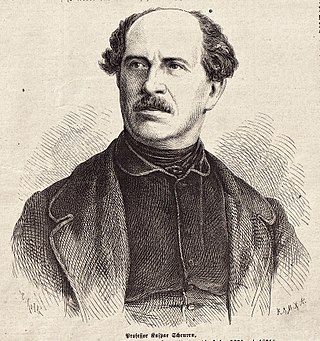Related Research Articles

Joseph Heinrich Beuys was a German artist, teacher, performance artist, and art theorist whose work reflected concepts of humanism, sociology, and, with Heinrich Böll, Johannes Stüttgen, Caroline Tisdall, Robert McDowell, and Enrico Wolleb, created the Free International University for Creativity & Interdisciplinary Research (FIU). He previously in his talks and performances also formed The Party for Animals and The Organisation for Direct Democracy. He was a member of a Dadaist art movement Fluxus and singularly inspirational in developing of Performance Art, called Kunst Aktionen, alongside Wiener Aktionismus that Allan Kaprow and Carolee Schneemann termed Art Happenings. Today, internationally, the largest performance art group is BBeyond in Belfast, led by Alastair MacLennan who knew Beuys and like many adapts Beuys's ethos.

Jörg Immendorff was a German painter, sculptor, stage designer and art professor. He was a member of the art movement Neue Wilde.
Emil Schult is a German painter, poet and audio-visual artist.

The Kunstakademie Düsseldorf is the academy of fine arts of the state of North Rhine Westphalia at the city of Düsseldorf, Germany. Notable artists who studied or taught at the academy include Joseph Beuys, Gerhard Richter, Magdalena Jetelová, Gotthard Graubner, Nam June Paik, Nan Hoover, Katharina Fritsch, Tony Cragg, Ruth Rogers-Altmann, Sigmar Polke, Anselm Kiefer, Rosemarie Trockel, Thomas Schütte, Katharina Grosse, Michael Krebber and photographers Thomas Ruff, Thomas Demand, Christopher Williams, Thomas Struth, Andreas Gursky and Candida Höfer. In the stairway of its main entrance are engraved the Words: "Für unsere Studenten nur das Beste".

Ewald Wilhelm Hubert Mataré was a German painter and sculptor, who dealt with, among other things, the figures of men and animals in a stylized form.

Orlando Mohorović is a Croatian artist. He is one of the original members of a group of artists called Labinski atelieri.
Imi Knoebel is a German artist. Knoebel is known for his minimalist, abstract painting and sculpture. The "Messerschnitt" or "knife cuts," is a recurring technique he employs, along with his regular use of the primary colors, red, yellow and blue. Knoebel lives and works in Düsseldorf.
Horst Gläsker is a German artist. His work is a symbiosis of music, dance, theatre, drawing, painting, sculpture, installation and architecture.
Social sculpture is a phrase used to describe an expanded concept of art that was invented by the artist and founding member of the German Green Party, Joseph Beuys. Beuys created the term "social sculpture" to embody his understanding of art's potential to transform society. As a work of art, a social sculpture includes human activity that strives to structure and shape society or the environment. The central idea of a social sculptor is an artist who creates structures in society using language, thoughts, actions, and objects.

Johan Nissen is a Danish new media artist specializing in digital art.
Fritz Schwegler was a German painter, graphic artist, sculptor and musician.

Peter Angermann is a German painter based in Nuremberg.

Anatol Herzfeld was a German sculptor and mixed-media artist, and also a policeman. A student of Joseph Beuys, he primarily used wood, iron and stone as materials. As an artist, he simply signed Anatol. He received attention for a happening, crossing the Rhine in a boat he created with Beuys, after Beuys had been expelled from the Kunstakademie Düsseldorf.
Erwin Heerich was a German artist.
Sonja Alhäuser is a German artist.

Wächter is a series of large outdoor iron sculptures by Anatol Herzfeld, a student of Joseph Beuys who was both a traffic policeman and an artist, with a recurring theme. The sculptures are located at various places in Germany. One of them watches over a positive change in the environment, another is a monument to policemen killed in the line of duty.

Heinrich Nauen was a German Expressionist artist. He created oils, watercolors, and prints; as well as murals and mosaics. A large part of his output consists of landscapes and floral still-lifes.
Joseph Bernhard Hubert Enseling was a German sculptor and university professor. Educated in Düsseldorf and Paris, he lectured at the Düsseldorf Art Academy and taught the artists Joseph Beuys and Hermann Blumenthal. His own work encompassed industrial and mining monuments as well as architectural sculptures. He also created portraits of personalities from the 1920s and 1930s.

Caspar Johann Nepomuk Scheuren was a German painter and illustrator.

Anton Josef Reiss, also Reiß was a German sculptor. Based in Düsseldorf, he focused on sacred art for churches, including a marble Pietà for St. Gereon in Cologne in a style close to the Nazarene movement.
References
- ↑ Johannes AmEnde, Joseph Beuys: Joseph Beuys und die Fettecke: eine Dokumentation zur Zerstörung der Fettecke in der Kunstakademie Düsseldorf, Edition Staeck, Heidelberg 1987, ISBN 3882430893